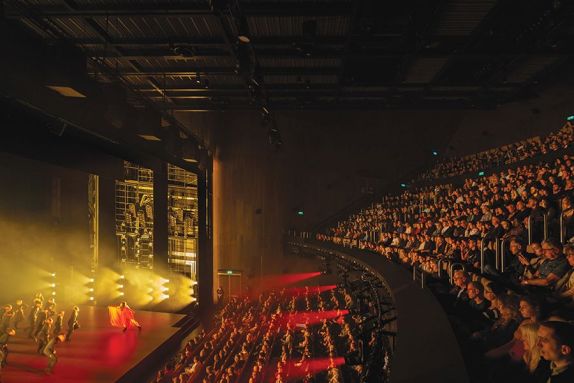The performance spaces at Aviva Studios allow for an intimate experience at scale. (Photo by Iwan Bann)
In 2023, two of the most complex and anticipated new theatre buildings in the world opened their doors to audiences for the first time. The Perelman Performing Arts Center (PAC NYC) in Manhattan, designed by the architecture firm REX, and Aviva Studios in Manchester, U.K., designed by the Office of Metropolitan Architecture (OMA), both enable radical flexibility, allowing artists and directors to configure the shape of the audience seating to suit their specific production needs.
These projects capitalize on decades of experimentation with flexible space, an investment in artistic freedom, and an effort to future-proof buildings to respond to the shifting vision of theatre artists as well as the needs of audiences. With multiple spaces on a single floor, both venues have movable acoustic walls, which allow for varying audience capacities, stage sizes, and new immersive, experimental formats not previously envisioned or possible. Many aspects of our human experience are highly affected by our environment, and our experience of art is no different. Bill Rauch, PAC NYC’s inaugural artistic director says, “The work gets deeper in the non-traditional audience-performer formats.”
The projects began concept design work in 2016, and both opened their doors in 2023. Much changed about the world during that period, but the project briefs for flexibility never shifted—at PAC NYC the tightly constrained site caused the designers to focus on intimacy, with the venues seating 450, 250, and 99 people in their standalone modes. At Aviva Studios, the main theatre seats 1,603, but the large, subdividable warehouse-like space abutting it can host standing room concerts and events for up to 5,000—combined, the hall and warehouse can house standing audiences of up to 7,000.
At both PAC NYC and Aviva Studios, each venue is separated by two movable walls, with a sizable air space in between, accomplishing full acoustic separation when both are deployed. Referred to as a “scene dock” this air space is sized to serve as critical backstage circulation and offstage support space for both venues it abuts. When the walls of the two spaces are removed, the scene dock becomes the stage, or a location for more audience seating.
Both buildings are in prominent urban centers and situated directly over and next to operating transit hubs, which allows for plenty of public engagement and opportunities for foot traffic. Aviva Studios is in busy central Manchester; the main auditorium cantilevers over the top of an operating roadway, and the entire building sits atop, and incorporates visual elements of historic railway arches into the public ground floor. Clad in glowing translucent marble, PAC NYC is located at the site of the World Trade Center and straddles a commuter train line to New Jersey and the 1 subway line.
The organizations that operate these two buildings have some similarities—neither had ever operated a permanent venue before opening the doors of their new buildings (though of course they have highly experienced staff and leadership). Aviva Studios is operated by Factory International, formerly
the Manchester International Festival, a major commissioner of new multi-disciplinary work since 2007. Their mission is simple, “invent tomorrow together.” In the first season, they’ve commissioned a multimedia and dance piece directed by Danny Boyle set in the world of The Matrix, “Free your Mind.” As John McGrath, the artistic director of Aviva Studios says, “[The building] feels like a space that loves artists, that cares about audiences.”

PAC NYC, on the other hand, is a completely new organization, created to operate the new Perelman Performing Arts Center. The emerging mission is to be a newfound place of connection; on a site of immense financial and cultural power, they want to be “where the world trades ideas.” In the first season, those ideas have included a hugely diverse mix of commissioning and presented work—from a Bill T. Jones-directed and -choreographed operatic piece, Watch Night, to a new production of Andrew Lloyd Webber’s Cats, set in the vibrant queer culture of contemporary ballroom dance competitions. The relatively small scale of the spaces presents audiences with a new opportunity to see these luminaries’ work in much more intimate environments than they are accustomed to.
Rauch thinks there is a “special magic when the audience can see itself.” And that magic, the new connections made by the configuration of the audience, can lead to the success or failure of a work. One of PAC NYC’s biggest hits this season, Between Two Knees, was set up in a thrust configuration, which Rauch thinks was at least partially responsible for its success.
In the first season, PAC NYC has used 13 of the 60+ pre-planned venue configurations. But flexing the venues is only a means to an end; Rauch’s feeling is that it’s about “expanding what artists can do. Before you talk about content, for an artist to be able to meaningfully configure their audience gets to the heart of why live performance is meaningful.”
These two projects together look to the future—one to invent it, the other to invite connections and dialogue from around the world. With these two organizations and their shiny new buildings as beacons, the future looks bright indeed.
Jerad Schomer (he/him) and Jenni Harris (she/her) are directors for Charcoalblue, the theatre design consultant for both PAC NYC and Aviva Studios.


